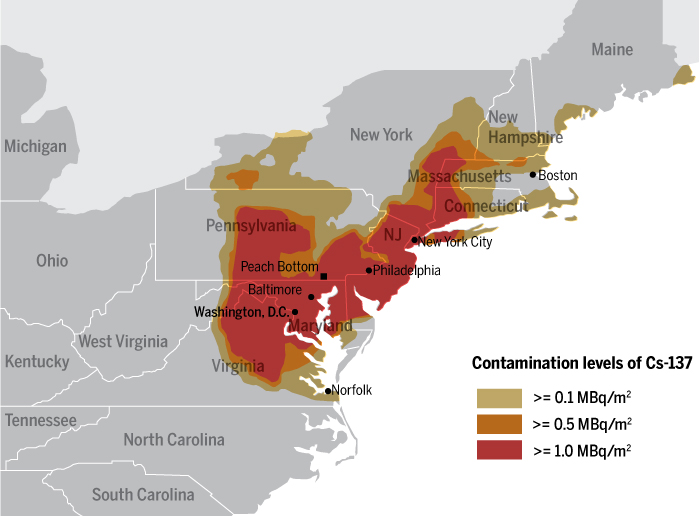Spent fuel fire on U.S. soil could dwarf impact of Fukushima
As reported by Richard Stone in Science Magazine, Princeton University researchers, running a sophisticated weather modeling computer program, have concluded that the U.S. Nuclear Regulatory Commission's estimates of consequences from a high-level radioactive waste storage pool fire are significantly downplayed.
Frank von Hippel, a nuclear security expert at Princeton University, teamed up with Princeton’s Michael Schoeppner on the modeling exercise.
The study examines the Peach Bottom nuclear power plant in Pennsylvania, a Fukushima Daiichi twin design, two reactor plant.
As the article reports:
In their simulations, the Princeton duo focused on Cs-137, a radioisotope with a 30-year half-life that has made large tracts around Chernobyl and Fukushima uninhabitable. They assumed a release of 1600 petabecquerels, which is the average amount of Cs-137 that NRC estimates would be released from a fire at a densely packed pool. It’s also approximately 100 times the amount of Cs-137 spewed at Fukushima. They simulated such a release on the first day of each month in 2015.
The contamination from such a fire on U.S. soil “would be an unprecedented peacetime catastrophe,” the Princeton researchers conclude in a paper to be submitted to the journal Science & Global Security. In a fire on 1 January 2015, with the winds blowing due east, the radioactive plume would sweep over Philadelphia, Pennsylvania, and nearby cities. Shifting winds on 1 July 2015 would disperse Cs-137 in all directions, blanketing much of the heavily populated mid-Atlantic region [see image, above left]. Averaged over 12 monthly calculations, the area exposed to more than 1 megabecquerel per square meter -- a level that would trigger a relocation order -- is 101,000 square kilometers [nearly 39,000 square miles]. That’s more than three times NRC’s estimate, and the relocation of 18.1 million people is about five times NRC’s estimates. (emphasis added)
Von Hippel also serves on a National Academies of Science (NAS) panel examining lessons to be learned from the Fukushima nuclear catastrophe. As also reported by Richard Stone in Science Magazine, that NAS panel has just released a major report. It reveals that a high-level radioactive waste storage pool fire was narrowly averted at Fukushima Daiichi by sheer luck. It also reveals that major security upgrades are needed at U.S. nuclear power plant high-level radioactive waste "wet" pool and dry cask storage facilities. (See the full NAS report here.)
NAS called on NRC to address safety and security risks to high-level radioactive waste storage as early as 2004. NRC never has, 15 years after the 9/11 attacks, and five years after the Fukushima nuclear catastrophe began.
Instead, NRC is considering rubber-stamping an application from Waste Control Specialists, LLC (WCS) in Andrews County, west Texas, to ship high-level radioactive waste by road, rail, and/or waterway, through most states. These shipments would be potential Mobile Chernobyls, Floating Fukushimas, and Dirty Bombs on Wheels, at risk of disastrous releases of radioactivity if breached by a high-speed crash, long-duration/high-temperature fire, underwater submersion, intentional attack, etc. WCS hopes to make a killing, by opening the first "centralized interim storage" facility (more accurately, a de facto permanent parking lot dump) for commercial irradiated nuclear fuel storage.
At the same time, the U.S. Department of Energy (DOE) is seeking to win "consent" for such a parking lot dump, conducting glorified PR "listening sessions" around the country. The next one is to be held in Boston, MA on June 2, 2016. (Given DOE's bad faith, it is all the more important that we register our non-consent, by the July 31, 2016 deadline!)
Many hundreds of environmental and public interest groups, representing all 50 states, have long called for Hardened On-Site Storage (HOSS) of irradiated nuclear fuel at reactor sites, as an interim measure to upgrade safety and security. The first step in HOSS is to empty the densely packed pools, so at risk of catastrophic fires. The name HOSS was coined by Dr. Arjun Makhijani of IEER in April 2002, at a conference in CT organized by Citizens Awareness Network of the Northeast, just before the major Yucca Mountain dump votes in the U.S. Congress that May and July. In Jan. 2003, Citizens Awareness Network commissed a report by Dr. Gordon Thompson of IRSS, putting flesh on the bones of the HOSS concept. In Sept. 2006, a coalition statement of principles was unveiled at a U.S. House hearing; the current version of the HOSS principles is dated March 2010. HOSS has been an organizing principle for the U.S. environmental movement ever since, including in interactions with the Congress, NRC, DOE, Blue Ribbon Commission on America's Nuclear Future (2010-2012), etc.
The 2004 NAS study calling on NRC to act was prompted by a Jan. 2003 report, authored by Alvarez et al. (including Von Hippel), documenting how catastrophic an irradiated nuclear fuel storage pool fire would be. That report came in the aftermath of the 9/11 attacks.
In May 2011, Robert Alvarez of Institute for Policy Studies followed up, in the aftermath of the beginning of the Fukushima nuclear catastrophe, with another study, showing the mega-catastrophes that could unfold at U.S. nuclear power plant high-level radioactive waste storage pools.
{What can you do to prevent such nuclear nightmares?! Contact your U.S. Senators, and your U.S. Represenative. (You can also get patched through to your Members of Congress's office via the U.S. Capitol Switchboard at (202) 224-3121.
Urge that Hardened On-Site Storage (HOSS) be required at all nuclear power plants, starting with the emptying of high-level radioactive wastes out of vulnerable storage pools, into hardened on-site dry casks (current status quo dry casks are not good enough -- another NRC failure). Urge that parking lot dumps, and the Mobile Chernobyl shipping risks they would launch, be stopped dead in their tracks. And urge that atomic reactors be permanently retired, so that no more high-level radioactive waste -- for which we have no good solution -- is generated.}






 May 26, 2016
May 26, 2016